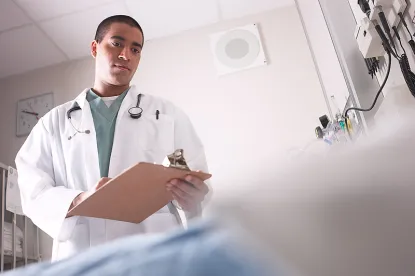As 2019 quickly approaches, we would like to take a few moments to reflect on the past year of Food and Drug Administration activities and certain big ticket items that made news in 2018. As the Magic 8-Ball would say: “signs point to yes” that everything on the list below will continue to be major areas of focus for both FDA and the U.S. Congress next year and into the foreseeable future. Just as health care, medicine, robotics, and information technology are rapidly evolving and intersecting, FDA has been forced to pick up the pace as the lead regulatory authority over therapeutic products, diagnostics, and medical devices, and to respond to the complexities of those traditionally distinct product categories. In many cases, where the Agency and its stakeholders want to go will require Congress to amend the law to give FDA authority to take that road, giving all players more opportunities to get involved in the process by submitting written comments, attending public workshops, and generally being visible during these complex and important debates.
But if there is a common theme from the items we’ve collected for you below, it’s that Commissioner Scott Gottlieb and Agency leadership throughout all of FDA’s Centers and interdisciplinary Offices have been putting forward wide-ranging plans for updating or reforming their respective programs to make the statutory and regulatory framework work better in the modern age of “big data.” The career professionals at FDA are very ably led in these modernization efforts by Commissioner Gottlieb, who has made robust announcements in the past year on almost every part of the Agency’s broad mandate, including in consumer product categories that we don’t typically cover on this site, such as dietary supplements, foods, and tobacco products . It’s exciting for us as FDA watchers, as well as consumers of these myriad regulated products, to see so much going on to move the public health forward in so many different ways.
So now, without further ado, here is our (selected and partial) list of the major activities from FDA over the past year – and if you’re interested in hearing a deep dive on the outlook for some of these for 2019, please join us for a Year-in-Review/2019 Outlook webinar on Thursday, February 7, 2019. More details on that to come on that in the new year!
Digital Health
In 2018, FDA continued to advocate for a new regulatory approach to software, including by releasing its thinking on how companies seeking precertification would be evaluated in a proposed regulatory model (aka “Pre-Cert”). Two publications—one in April and another in June—outlined the Agency’s thinking and solicited public reactions to those ideas. In October, Democratic Senators on the Health, Education, Labor, and Pensions (HELP) Committee sought the Agency’s feedback on key questions related to the program’s operation as well as the legal authority for such a program. For more on this topic, check out our blog series on artificial intelligence, including specifically our take on FDA’s approach to AI, and the first in our Pre-Cert series.
On October 18, 2018, the FDA published a draft guidance, “Content of Premarket Submissions for Management of Cybersecurity in Medical Devices,” which, once finalized, will supersede the current final guidance of the same name issued in October 2014. The draft guidance provides updated recommendations to industry regarding cybersecurity device design, labeling, and the documentation that the FDA recommends be included in premarket submissions for devices facing cybersecurity risks. FDA will host a public meeting on January 29-30, 2019 to solicit more public feedback on the draft guidance, so this is definitely a topic we are following into 2019.
Additionally, FDA issued a series of guidance documents in late 2017 to align with the changes required by the 21st Century Cures Act, which was signed into law in December 2016. In December 2018, the Agency released its first report on the health impact of the non-device software functions that were carved out of FDA regulation by the 21st Century Cures Act. The bottom line is that FDA found that the regulatory carve out is justified—consumers and health care providers benefit from these software functions and the products are very low risk. This signals that FDA is continuing on a path of deregulation of low risk software devices and functions. We will continue to watch for the finalization of the Clinical Decision Support guidance in 2019 as that is a critical industry guidance that fell short of industry expectations and leaves an area of uncertainty for stakeholders in the digital health space.
Laboratory Tests and Clinical Use of Next-Gen Sequencing
FDA ignited a firestorm in 2014 when it released draft guidance that proposed more active regulation of lab tests, and that blaze continued to burn in 2018. Of note this year is FDA’s feedback on the previously introduced Diagnostic Accountability and Innovation Act (DAIA). That Agency feedback essentially became a new bill that Congress turned into the Verifying Accurate Leading-edge IVCT Development (VALID) Act. Two key features of the VALID bill that are most likely to appeal to diagnostics companies are pre-certification and review by accredited persons (i.e., third party review), both of which have to the potential to minimize FDA premarket review of individual tests.
And, although separate from the how-should-we-regulate-lab-tests question, FDA took several big steps this year to continue advancing the use of next-generation genomic sequencing (NGS) in clinical practice. On December 4, 2018, the Agency announced the first recognition of an open database of genetic variant information as a source of valid scientific evidence, allowing that database to be used by NGS test developers to support clinical validity in premarket submissions for those tests. This milestone was achieved by the Clinical Genome Resource (ClinGen) consortium’s ClinGen Expert Curated Human Genetic Data. The FDA recognition decision was based on an extensive review of ClinGen’s policies and procedures, and also followed the Agency’s finalization of a 2016 draft guidance earlier in the year on the “Use of Public Human Genetic Variant Databases to Support Clinical Validity for Genetic and Genomic-Based In Vitro Diagnostics.”
Other notable NGS milestones in 2018 include the de novo-authorization of the first NGS-based test to detect minimal residual disease in certain leukemia patients through an assessment of very low levels of cells – the test is capable of detecting MRD even at levels below 1 in 1 million cells. FDA also made mainstream news this year with its authorization of several new direct-to-consumer genetic tests, albeit with lengthy and detailed special controls associated with each of them.
510(k) Modernization & De Novo Proposed Rule
We may look back at 2018 as the beginning of the end for the 510(k) program as it has existed since the 1976 Medical Device Amendments. FDA took a variety of actions intended to modernize the 510(k) program this past year, including issuing a draft guidance that envisions changes to the abbreviated 510(k) program and a major announcement about using more modern predicates. The latter has some wondering how forcefully and under what authority FDA would require a predicate to be (as was suggested in the announcement) no more than 10 years old. Even referring to “the 510(k) pathway” may become passé, as FDA is proposing new terminology for its modernized program: the “Safety and Performance Based Pathway.”
The release of the long-awaited De Novo classification process proposed rule also relates to modernizing the 510(k) program because, if FDA believes a predicate is not modern enough, the Agency may push manufacturers to submit so-called De Novo requests. The proposed rule, when finalized, will provide clarity on De Novo submission content and review process, but with that clarity are likely to come some potential new challenges for industry, such as the submission of device samples, pre-market inspection, and increased clinical evidence requirements.
Device Enforcement and Compliance
The CMMI Case for Quality assessment pilot done in 2018 is already being touted as a success by the Agency. Quality appraisals looked at continuous quality improvements and participants in the pilot reaped real benefits, like delayed inspections, waiving pre-approval inspections, and other benefits. We expect the program to be finalized and rolled out officially in 2019. The past year also saw an unexpected growth in the Medical Device Single Audit Program (MDSAP), with stakeholders reporting positively on the program at a public meeting in May and almost 13,000 participant U.S. sites enrolled in 2018. We will be evaluating the compliance and enforcement trends as 2018 data becomes available in the coming weeks. However, some early conclusions of our assessment include a significant reduction in device Warning Letters, despite FDA-reported increases in inspectional activities, and signals that industry’s voluntary compliance efforts are aligned with FDA’s compliance expectations.
Drug Competition Action Plan and Biosimilars Action Plan
On the drug and biologics side of the FDA house, Commissioner Gottlieb continued his aggressive promotion of the Agency’s Drug Competition Action Plan (DCAP) and Biosimilars Action Plan (BAP), with a large number of individual actions taken by FDA under each of those broader frameworks in 2018, including creating a public list of companies who have blocked generic sponsors from moving forward by withholding needed samples of the innovator product. As we’ve previously written about (see here and here), these FDA efforts are a significant piece of the Trump Administration’s blueprint for bringing down high drug prices, with the Agency’s goal being to close backlogs and loopholes and speed market entry of generics and biosimilars in order to expand available options and competition among all therapeutic products.
Although it’s been somewhat overshadowed with bigger news, in July 2018 the Commissioner announced the formation of an internal working group to explore options for importing certain medicines with only a single manufacturer, provided there are no blocking patents or exclusivities associated with the drug. We haven’t heard much in this area since then, but it seems reasonable to expect some sort of working group report or at least a follow-up announcement from Dr. Gottlieb on the drug importation idea sometime in 2019. Any policy change in this area would represent a significant departure from the last 80 years of the nation’s closed-distribution system for prescription drugs.
Most recently under the auspices of the DCAP/BAP, on December 11, 2018, FDA released a slew of biosimilars-related policy documents along with a lengthy statement from the Commissioner. In his statement, Dr. Gottlieb previewed some additional policy changes under the BAP, including providing feedback on study protocols from biosimilar sponsors and issuing letters to reference product sponsors to confirm that they can lawfully provide samples to the biosimilar developer. The Commissioner emphasized again that:
While the limited distribution programs can have a role in promoting patient safety, too many branded products are still misusing these programs as rhetorical smokescreens to hide anti-competitive behavior. We’re not going to be partners to these deceptions.
In short, there will certainly be much more to come under these competition-focused Action Plans and certainly lots more for biosimilars as the Agency continues to implement the relatively new program. (And even, potentially, some drama if the Affordable Care Act is declared unconstitutional on appeal from the Texas v. Azar decision, since that 2010 law includes the amendments to FDA’s statutes that created the biosimilar approval pathway in the first place!)
Regenerative Medicine and Gene Therapy
FDA also continued to take steps across the different work streams that comprise its Comprehensive Regenerative Medicine Policy framework that was introduced over the course of several months in 2017 (for a recap, see our year-end summary from last year here). The Agency kicked off the new year in January 2018 with another warning letter to a cellular/tissue-product manufacturer and then in May filed federal complaints seeking permanent injunctions against two stem cell clinics for continued violations of the Food, Drug, and Cosmetic Act. In a public address in Washington, D.C. on December 12, 2018, Commissioner Gottlieb reiterated his focus on advancing legitimate regenerative medicine therapies while protecting consumers from unapproved treatments, stating:
We’ll be stepping up actions in this space in the coming months. Expect to see brisk activity from the FDA when it comes to some rogue stem cell outfits that are putting patients at risk. We’re also going to be putting many more firms on notice that we’re aware that they’re manufacturing cell and tissue products that are subject to our oversight. And we expect to hear from them.
Those actions began soon thereafter, with an announcement on December 20, 2018, of another stem cell warning letter being issued and of educational “It Has Come to Our Attention” letters being sent to what appears to be a large number of other persons and companies.
On the side of product developers working within FDA’s regulatory framework, in July 2018, the Agency released a series of gene therapy guidance documents in draft form for public comment, a couple of which were revised from a decade ago to reflect scientific advancements since that time. A more unexpected development (at least from our vantage point) was the proposal released in August 2018 to streamline the safety review process for gene therapy clinical trials by, among other things, refocusing the oversight of the NIH Recombinant DNA Advisory Committee on emerging technologies. In addition to the formal publication for notice-and-comment, the Federal government’s proposal to modernize the oversight of human gene therapy research was jointly announced by Commissioner Gottlieb and NIH Director Francis Collins in the New England Journal of Medicine. Finally, publicly available data also indicate that, as of the end of October 2018, FDA had granted 26 Regenerative Medicine Advanced Therapy (RMAT) Designation requests since that expedited program was created by Congress with the 21st Century Cures Act.
Modernizing the Drug Development and Review Process
And last, but certainly not least, FDA has kicked off a wide array of initiatives and programs intended to modernize the drug development and review/approval process, including by more actively incorporating the patient perspective into regulatory decision-making. This topic of drug approval modernization deserves its own blog post, but for purposes of this recap we wanted to highlight one of the most recent and exciting announcements. On December 6, 2018, the Agency released its “Framework for the Real-World Evidence Program” that outlines key action items for FDA’s continued assessment for how to use real-world evidence (RWE) and real-world data (RWD) to create efficiencies for drug and biologic applicants and agency reviewers. This RWE Framework is another deliverable that had been mandated by the 21st Century Cures Act – and the Agency is accepting comments on the draft document until February 5, 2019.





 />i
/>i
